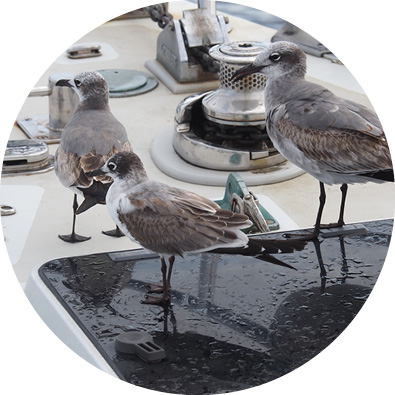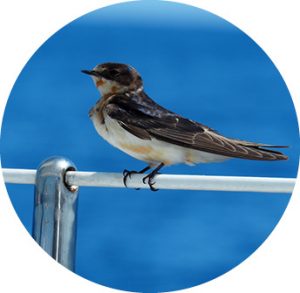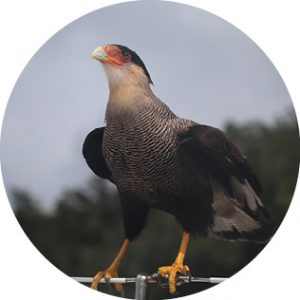By Dorothy Wadlow, Cruising Club of America Essex Station
As an enthusiastic birdwatcher, I’ve gained a reputation as the “Bird Lady.” Friends often share stories of birds they’ve seen or pictures of birds they want to identify. My sailing friends tell me about birds that landed on their boat. I can see why. It’s very exciting to be alone at sea on your little “floating island” when an avian fellow traveler pays a visit far from its usual habitat. Here’s what I’ve learned about birds on boats, along with a few of my favorite encounters.

Two laughing gulls and one Franklin’s gull on Joyant between Galapagos and Panama © Greg Stoltz

Molting barn swallow offshore on Joyant © Greg Stoltz

Crested caracara checks us out in Chilean Patagona © Tom Wadlow
Migrating Land Birds
Around the world, boaters are active offshore in spring and fall, when birds are migrating. Some birds migrate over the water, and others end up there due to offshore winds, inexperience, or defective migration skills. We witnessed a dramatic example of this phenomenon on our Able Apogee 50, Joyant, during an October overnight south from Sandy Hook, New Jersey, to Norfolk, Virginia.
We left at first light on the day after a front had come through. Winds were northwest 15–20 knots. We were sailing fast, staying close to shore to keep the fetch down. Throughout the day, small birds kept landing on Joyant. The next day, the wind decreased, but birds kept arriving. My list totaled ten birds (eight species) over the two days:
eastern meadowlark
white-throated sparrow (2)
ruby-crowned kinglet
common yellowthroat
chipping sparrow
palm warbler
swamp sparrow
yellow-rumped warbler (2)
These visitors’ lives don’t usually have happy endings. It’s the weakest that need a place to rest offshore. Either they die on board or head off again with little chance of making it ashore due to fatigue or predation. My list included one bird with a round mud ball attached to its leg, one immature bird, and one bird with very few tail feathers chased by five gulls. I made food and water available. We don’t carry birdseed aboard, but I offered sesame seeds from my spice cabinet. Nine of the birds had no interest.
Part of the problem was five of the species on the list eat insects, not seeds. The exception was an adult white-throated sparrow, the perkiest of them all, which both ate and drank. It tried leaving several times but always came back, once being chased by a small falcon. After it disappeared at dark, we feared the worst. But just before sunrise the next morning, it emerged from a cockpit storage space and ate and drank again. When a fishing boat appeared closer to shore west of us, it switched rides. We like to think it survived.
Surprisingly, small birds visiting boats sometimes have no fear of humans. Landing aboard a moving object is a last resort. They often circle the boat several times before trying it. But once they have landed, if you move slowly, they think you are part of the boat. They hop across laps, land on shoulders, sit right on the nav area where you are working, and even go below. The first time this happened to us was in California when we were racing Newport to Ensenada aboard our J/36, Jaywalker, with three parents and three teenagers aboard. A tired little Townsend’s warbler visited and jumped on our friend Dave’s head. Dave froze, and the warbler stayed — a never-to-be-for- gotten moment for the entire crew.
Birds Aboard Hints
• You’re most likely to encounter birds at sea in spring and fall when offshore winds cause migrating birds to be over the water and looking for a place to land.
• If a migrant bird does land on your boat, move slowly and don’t try to catch it. It might come to you.
• Offer food and water, but don’t be surprised if it isn’t accepted.
• If you can ID the species, you might learn what it eats. My favorite on-board ID tools are phone apps: the Sibley Guide to Birds (not free, but it downloads a whole book and bird sounds that you can use without an internet connection) and Cornell Lab’s free Merlin Bird ID (requires internet).
• Take a photo, and you can work on the ID later. Seabirds are skittish when onboard. Photograph them carefully, or you will lose your subject.

Seabirds
I’ve never heard of true pelagic seabirds, like shearwaters, fulmars, and petrels, landing on a small boat. They are at home and self-sufficient on the ocean and don’t need a perch. But birds that live on land and feed at sea, like gulls, terns, boobies, and frigatebirds, sometimes appreciate a rest stop. They are much more skittish than the exhausted land-based migrants and usually stay away from humans. Halfway from the Galapagos to the Panama Canal, three gulls a long way from their comfort zone visited us one morning, but stayed on the bow and took off when we humans got more active.
My favorite seabird-on-board story involves the Inca tern. Most terns are primarily white, but Inca terns are different. They are dark, with white-edged wings and fire-engine-red legs, bills, and feet. The wow factor comes from a few long white feathers just aft of the bill, which curve down and back like a handlebar mustache and are enhanced by a featherless bright-yellow gape beyond the base of the bill.
Inca terns only occur in the waters off Peru and northern Chile. When we were on a passage from Panama to Chile in 2014 with Frank Bohlen aboard, I studied my sources to see what seabirds to expect. Inca tern flew to the top of my wish list. I always take the early morning watch when birds are most active. One morning, I got my wish. Two Inca terns landed on our dinghy in its davits. They seemed relaxed and soon moved onto the deck. I whispered down through the hatch, “Inca terns on the boat! Bring your cameras.” Tom and Frank were less than enthusiastic until they saw the birds, and then the shutters clicked wildly. ■
Dorothy Wadlow. has been interested in birds since she was a child and interested in sailing since she met Tom Wadlow fifty-eight years ago. Birding dovetailed perfectly with their cruising lifestyle. She looked for birds both at sea and ashore during their twenty-two years (90,000 miles) aboard their Able Apogee 50, Joyant, and five years (10,000 miles) aboard their PDQ 41 power cat, Felix. There were always new birds to see, and her journals are full of bird lists, which she reported to the Cornell Lab of Ornithology’s worldwide database, eBird. Along the way, she earned her USCG 100-ton master’s license and enthusiastically shared her hobby with anyone who would listen.
With thanks to the Cruising Club of America in whose magazine, Voyages Issue 66 this article first appeared, and Voyages editors Amelia & Robert Green.
The Cruising Club of America (CCA) is a collection of 1,400 ocean sailors with extensive offshore seamanship, command experience, and a shared passion for making adventurous use of the seas. Their experiences and expertise make them, collectively, one of the most reliable sources of information on offshore sailing. Visit cruisingclub.org to learn more.




